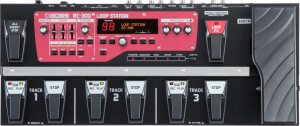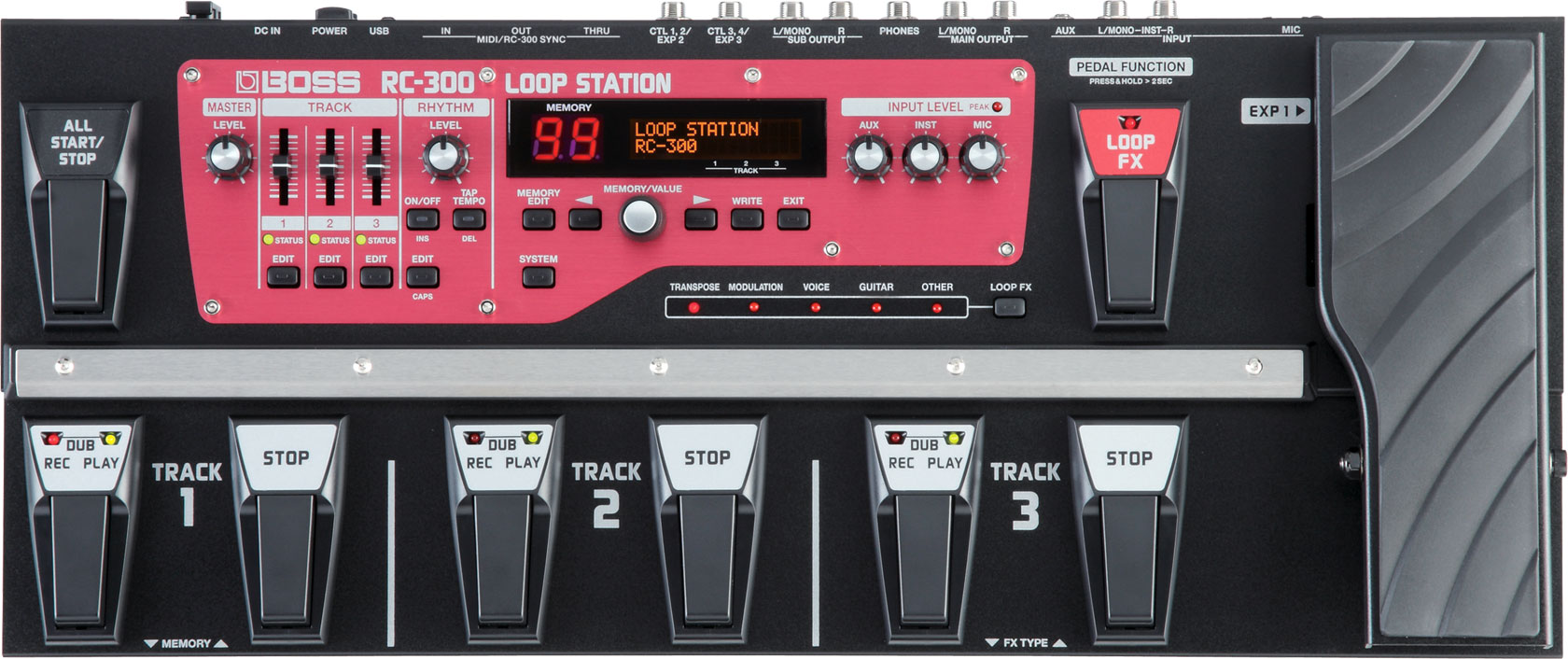View other reviews for this product:
« Very Helpful »
Published on 11/13/13 at 04:40General information on the manufacturer's page: https://www.rolandce.com/fr/fr/produits/guitare-basse/loop-stations/rc-300/
In short:
Loop Station 3 tracks + multi-effects with expression pedal.
Each track is assigned two footswitch PLAY / REC / DUB STOP. And a volume fader and an EDIT button to track parameters.
A RHYTHM part with a volume knob, with a TAP TEMPO LED, ON / OFF and EDIT
The "multi-purpose" includes five sections: TRANSPOSE, MODULATION, VOICE, GT / BASS OTHERS. It contains a transposition effect - / +12 semitones, flanger, phaser, pan, tremolo, slicer, bend, chorus, Robot Voice, Male, Female, Guitar> Bass, Filter, Delay, Lo-Fi, Distortion.
All, or nearly all, are configurable (volume, rate, drive, etc. ... no EQ though).
A knob allows for infinite rotation to navigation button and the "<" and ">".
SYSTEM is used to set general parameters: Screen contrast and asignation all controllers of the pedal.
MEMORY EDIT to the parameter memory (all three tracks): Renowned memories, their volume, tempo, fade in / out, reverb, assignment of external controllers.
Three knob for INPUT VOLUME, AUX (auxiliary mini-jack), INST (input jacks) MIC (XLR input).
The FX LOOP switch to turn off the effects, and the expression pedal to modulate.
The connectors are:
DC IN (supplied AC) POWER, USB (cable not included), MIDI IN / THRU / OUT, 2 inputs for external pedal control, headphone jack, mono outputs / Stereo Aux / mono / stereo / XLR
UTILIZATION
Considering all the options available, it should sincerely consider the manual and tweak some settings to all comprendres use. It'll be two years that I have and there are still some function that I'm not going to change (eg assignment.).
The manual is fairly comprehensive and understandable.
Once taken in hand, it is very intuitive, all rules in 2sec. You do not spend 10 minutes on stage to adjust knowing that all your settings are recordable.
Very flexible pedal, it folds almost all your requirements.
I also use the pedal as a recorder, I write my songs on paper records each part of the RC-300. Then the extract on my computer via a USB cable (not supplied) A male / B male. Between all in a DAW or digital sequence. This allows me to have no external sound card, a treaty audio WAV rather good.
SOUND QUALITY
The effects are not those that may have to find real pedal. They are there to give a general idea of a sound you could get with a real config.
Some are very clean and the other less (Various distortion. Still very digital).
Simulation at low tendency to get quite often, but enough to make the bass line with a guitar to work. Following in his final is a bit too rough.
Either way, this is a pedal loops and no multi-effects. For sound reproduction, it is perfect, even when it slows time aliasing remains low (with reasonable deviations, if you move from one record to 200bpm to 60bpm reading it necessarily has a sound too "digital "However, the pedal tells you to" TOO SLOW "or" TOO FAST ".
The effects are assignable multi point INPUT TRACK 1/2/3 MAINOUT TRACKS, MAINOUT TR & RHY, MAINOUT TOTAL. Warning malgrès the great number available. effects, we do not make chain effect, one is usable. We can still superimposed tracks with different effects when applied input.
For drum rhythms recorded is very complete: 2/4, 3/4, 4/4, 5/4, 6/4, 7/4, 5/8, 6/8, 7/8, 8 / 8, 9/8, 10/8, 11/8, 12/8, 13/8, 14/8, 15/8 with different style in another Simple Beat, Rock, Downbeat, Funk, Groove, Bossa, Samba, Swing, Pop, Fusion, hit hat, Congas, Latin Rock, Shuffle (1/2, 16th), 909 Beat (electro), R & B, Claves ...
For me, some critical to come to this section:
The style statements are not all available. on all metrics with some glaring oversight (no swing 3/4!). And for me, the biggest oversight, a METRONOME. A simple click is not configurable for refusal. For common measures is not too annoying, but asymmetric measures are divisible x ways and we must "settle" predefined divisions.
However, with a USB cable (A Male / B Male not included) can be inserted in the audio track of the pedal and then make your own rhythm patterns on a computer. They will not affect on the other hand by changes in tempi of the pedal.
OVERALL OPINION
I use this pedal for 2 years now, I am more than satisfied. It allows me to bosser almost all of my pieces (you have to work to change the metric on its own or with an imported audio track). Some forgotten though. The pedal is sometimes updated, for now, only one update to my knowledge that corrected a bug on some pedal ("TOO BUSY" / "MEMORY FULL" while this is not the case). For now the updates will not insert functionality or other and I do not think that pre-occupies the BOSS team.
This is the only model that I actually tried. I hit quickly make the RC-30 but I found it a bit limited. I'm not really interested in the model of other brands.
The +:
Quantity-features
-Storage Capacity
-Various metrics available. in various style
-Reliable and Solid (BOSS what)
-Flexibility
The -:
The price-
-The size (do not think the carry in a backpack)
Non-cumulative effects
-Unable to change memory during playback
No-click / metronome
The quality / price ratio ... pedal is expensive but does a very good job and seems inexhaustible. This is a good investiment when we have the means. It allows a thorough working quietly at home (recording grids, compos ...).
I never use it on stage, except for the launch some pre-recorded samples. I feel used primarily to work the guitar and recording little demo. I play mostly Jazz, and suddenly some oversights (like the abscence of swing 3/4) strikes me a little but it's quibbling.
I certainly do this choice.
In short:
Loop Station 3 tracks + multi-effects with expression pedal.
Each track is assigned two footswitch PLAY / REC / DUB STOP. And a volume fader and an EDIT button to track parameters.
A RHYTHM part with a volume knob, with a TAP TEMPO LED, ON / OFF and EDIT
The "multi-purpose" includes five sections: TRANSPOSE, MODULATION, VOICE, GT / BASS OTHERS. It contains a transposition effect - / +12 semitones, flanger, phaser, pan, tremolo, slicer, bend, chorus, Robot Voice, Male, Female, Guitar> Bass, Filter, Delay, Lo-Fi, Distortion.
All, or nearly all, are configurable (volume, rate, drive, etc. ... no EQ though).
A knob allows for infinite rotation to navigation button and the "<" and ">".
SYSTEM is used to set general parameters: Screen contrast and asignation all controllers of the pedal.
MEMORY EDIT to the parameter memory (all three tracks): Renowned memories, their volume, tempo, fade in / out, reverb, assignment of external controllers.
Three knob for INPUT VOLUME, AUX (auxiliary mini-jack), INST (input jacks) MIC (XLR input).
The FX LOOP switch to turn off the effects, and the expression pedal to modulate.
The connectors are:
DC IN (supplied AC) POWER, USB (cable not included), MIDI IN / THRU / OUT, 2 inputs for external pedal control, headphone jack, mono outputs / Stereo Aux / mono / stereo / XLR
UTILIZATION
Considering all the options available, it should sincerely consider the manual and tweak some settings to all comprendres use. It'll be two years that I have and there are still some function that I'm not going to change (eg assignment.).
The manual is fairly comprehensive and understandable.
Once taken in hand, it is very intuitive, all rules in 2sec. You do not spend 10 minutes on stage to adjust knowing that all your settings are recordable.
Very flexible pedal, it folds almost all your requirements.
I also use the pedal as a recorder, I write my songs on paper records each part of the RC-300. Then the extract on my computer via a USB cable (not supplied) A male / B male. Between all in a DAW or digital sequence. This allows me to have no external sound card, a treaty audio WAV rather good.
SOUND QUALITY
The effects are not those that may have to find real pedal. They are there to give a general idea of a sound you could get with a real config.
Some are very clean and the other less (Various distortion. Still very digital).
Simulation at low tendency to get quite often, but enough to make the bass line with a guitar to work. Following in his final is a bit too rough.
Either way, this is a pedal loops and no multi-effects. For sound reproduction, it is perfect, even when it slows time aliasing remains low (with reasonable deviations, if you move from one record to 200bpm to 60bpm reading it necessarily has a sound too "digital "However, the pedal tells you to" TOO SLOW "or" TOO FAST ".
The effects are assignable multi point INPUT TRACK 1/2/3 MAINOUT TRACKS, MAINOUT TR & RHY, MAINOUT TOTAL. Warning malgrès the great number available. effects, we do not make chain effect, one is usable. We can still superimposed tracks with different effects when applied input.
For drum rhythms recorded is very complete: 2/4, 3/4, 4/4, 5/4, 6/4, 7/4, 5/8, 6/8, 7/8, 8 / 8, 9/8, 10/8, 11/8, 12/8, 13/8, 14/8, 15/8 with different style in another Simple Beat, Rock, Downbeat, Funk, Groove, Bossa, Samba, Swing, Pop, Fusion, hit hat, Congas, Latin Rock, Shuffle (1/2, 16th), 909 Beat (electro), R & B, Claves ...
For me, some critical to come to this section:
The style statements are not all available. on all metrics with some glaring oversight (no swing 3/4!). And for me, the biggest oversight, a METRONOME. A simple click is not configurable for refusal. For common measures is not too annoying, but asymmetric measures are divisible x ways and we must "settle" predefined divisions.
However, with a USB cable (A Male / B Male not included) can be inserted in the audio track of the pedal and then make your own rhythm patterns on a computer. They will not affect on the other hand by changes in tempi of the pedal.
OVERALL OPINION
I use this pedal for 2 years now, I am more than satisfied. It allows me to bosser almost all of my pieces (you have to work to change the metric on its own or with an imported audio track). Some forgotten though. The pedal is sometimes updated, for now, only one update to my knowledge that corrected a bug on some pedal ("TOO BUSY" / "MEMORY FULL" while this is not the case). For now the updates will not insert functionality or other and I do not think that pre-occupies the BOSS team.
This is the only model that I actually tried. I hit quickly make the RC-30 but I found it a bit limited. I'm not really interested in the model of other brands.
The +:
Quantity-features
-Storage Capacity
-Various metrics available. in various style
-Reliable and Solid (BOSS what)
-Flexibility
The -:
The price-
-The size (do not think the carry in a backpack)
Non-cumulative effects
-Unable to change memory during playback
No-click / metronome
The quality / price ratio ... pedal is expensive but does a very good job and seems inexhaustible. This is a good investiment when we have the means. It allows a thorough working quietly at home (recording grids, compos ...).
I never use it on stage, except for the launch some pre-recorded samples. I feel used primarily to work the guitar and recording little demo. I play mostly Jazz, and suddenly some oversights (like the abscence of swing 3/4) strikes me a little but it's quibbling.
I certainly do this choice.



